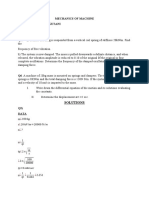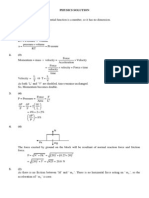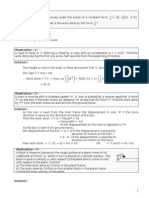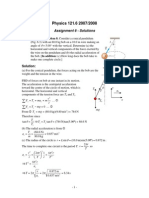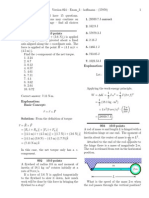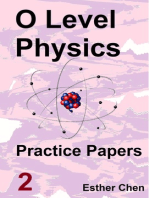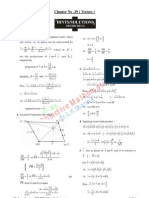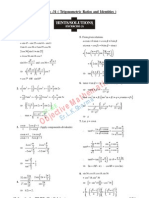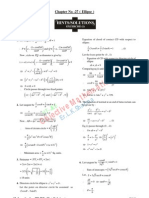Chapter 5 Newton's Laws of Motion
Chapter 5 Newton's Laws of Motion
Uploaded by
PremCopyright:
Available Formats
Chapter 5 Newton's Laws of Motion
Chapter 5 Newton's Laws of Motion
Uploaded by
PremOriginal Description:
Copyright
Available Formats
Share this document
Did you find this document useful?
Is this content inappropriate?
Copyright:
Available Formats
Chapter 5 Newton's Laws of Motion
Chapter 5 Newton's Laws of Motion
Uploaded by
PremCopyright:
Available Formats
5.
1
SOLUTIONS TO CONCEPTS
CHAPTER 5
1. m = 2kg
S = 10m
Let, acceleration = a, Initial velocity u = 0.
S= ut + 1/2 at
2
10 = a (2
2
) 10 = 2a a = 5 m/s
2
Force: F = ma = 2 5 = 10N (Ans)
2. u = 40 km/hr =
3600
40000
= 11.11 m/s.
m = 2000 kg ; v = 0 ; s = 4m
acceleration a =
s 2
u v
2 2
=
( )
4 2
11 . 11 0
2 2
=
8
43 . 123
= 15.42 m/s
2
(deceleration)
So, braking force = F = ma = 2000 15.42 = 30840 = 3.08 10
4
N (Ans)
3. Initial velocity u = 0 (negligible)
v = 5 10
6
m/s.
s = 1cm = 1 10
2
m.
acceleration a =
s 2
u v
2 2
=
( )
2
2
6
10 1 2
0 10 5
=
2
12
10 2
10 25
= 12.5 10
14
ms
2
F = ma = 9.1 10
31
12.5 10
14
= 113.75 10
17
= 1.1 10
15
N.
4.
g = 10m/s
2
T 0.3g = 0 T = 0.3g = 0.3 10 = 3 N
T
1
(0.2g + T) =0 T
1
= 0.2g + T = 0.2 10 + 3 = 5N
Tension in the two strings are 5N & 3N respectively.
5.
T + ma F = 0 T ma = 0 T = ma (i)
F= T + ma F= T + T from (i)
2T = F T = F / 2
6. m = 50g = 5 10
2
kg
As shown in the figure,
Slope of OA = Tan
OD
AD
=
3
15
= 5 m/s
2
So, at t = 2sec acceleration is 5m/s
2
Force = ma = 5 10
2
5 = 0.25N along the motion
fig 1
0.2kg
0.3kg
0.2kg
fig 3
0.2g
T
1
T
fig 2
0.3g
0.3kg
A
Fig 2
mg
T
R
F
B
Fig 3
mg
ma
R
T
B
Fig 1
S
A
2
v(m/s)
180u
u
A B
C D E
u
4 6
5
15
10
Chapter-5
5.2
At t = 4 sec slope of AB = 0, acceleration = 0 [ tan 0 = 0]
Force = 0
At t = 6 sec, acceleration = slope of BC.
In BEC = tan =
EC
BE
=
3
15
= 5.
Slope of BC = tan (180 ) = tan = 5 m/s
2
(deceleration)
Force = ma = 5 10
2
5 = 0.25 N. Opposite to the motion.
7. Let, F contact force between m
A
& m
B
.
And, f force exerted by experimenter.
F + m
A
a f = 0 m
B
a f =0
F = f m
A
a .(i) F= m
B
a ...(ii)
From eqn (i) and eqn (ii)
f m
A
a = m
B
a f = m
B
a + m
A
a f = a (m
A
+ m
B
).
f =
B
m
F
(m
B
+ m
A
) =
|
|
.
|
\
|
+
B
A
m
m
1 F [because a = F/m
B
]
The force exerted by the experimenter is
|
|
.
|
\
|
+
B
A
m
m
1 F
8. r = 1mm = 10
3
m = 4mg = 4 10
6
kg
s = 10
3
m.
v = 0
u = 30 m/s.
So, a =
s 2
u v
2 2
=
3
10 2
30 30
= 4.5 10
5
m/s
2
(decelerating)
Taking magnitude only deceleration is 4.5 10
5
m/s
2
So, force F = 4 10
6
4.5 10
5
= 1.8 N
9. x = 20 cm = 0.2m, k = 15 N/m, m = 0.3kg.
Acceleration a =
m
F
=
x
kx
=
( )
3 . 0
2 . 0 15
=
3 . 0
3
= 10m/s
2
(deceleration)
So, the acceleration is 10 m/s
2
opposite to the direction of motion
10. Let, the block m towards left through displacement x.
F
1
= k
1
x (compressed)
F
2
= k
2
x (expanded)
They are in same direction.
Resultant F = F
1
+ F
2
F = k
1
x + k
2
x F = x(k
1
+ k
2
)
So, a = acceleration =
m
F
=
m
) k x(k
2 1
+
opposite to the displacement.
11. m = 5 kg of block A.
ma = 10 N
a 10/5 = 2 m/s
2
.
As there is no friction between A & B, when the block A moves, Block B remains at rest in its position.
Fig 1
s
m1 m2 f
F
R'
mBg
mBa
Fig 3
F
R
mAg
mBa
Fig 2
F1
m
x
K1
F2
K2
10N
A
B
0.2m
Chapter-5
5.3
Initial velocity of A = u = 0.
Distance to cover so that B separate out s = 0.2 m.
Acceleration a = 2 m/s
2
s= ut + at
2
0.2 = 0 + () 2 t
2
t
2
= 0.2 t = 0.44 sec t= 0.45 sec.
12. a) at any depth let the ropes make angle with the vertical
From the free body diagram
F cos + F cos mg = 0
2F cos = mg F =
u cos 2
mg
As the man moves up. increases i.e. cos u decreases. Thus F
increases.
b) When the man is at depth h
cos u =
2 2
h ) 2 / d (
h
+
Force =
2 2
2
2
h 4 d
h 4
mg
h
4
d
h
mg
+ =
+
13. From the free body diagram
R + 0.5 2 w = 0
R = w 0.5 2
= 0.5 (10 2) = 4N.
So, the force exerted by the block A on the block B, is 4N.
14. a) The tension in the string is found out for the different conditions from the free body diagram as
shown below.
T (W + 0.06 1.2) = 0
T = 0.05 9.8 + 0.05 1.2
= 0.55 N.
b) T + 0.05 1.2 0.05 9.8 = 0
T = 0.05 9.8 0.05 1.2
= 0.43 N.
c) When the elevator makes uniform motion
T W = 0
T = W = 0.05 9.8
= 0.49 N
d) T + 0.05 1.2 W = 0
T = W 0.05 1.2
= 0.43 N.
e) T (W + 0.05 1.2) = 0
T = W + 0.05 1.2
= 0.55 N
s
10N
R
w
ma
F
d
Fig-1
u
d/2
F
Fig-2
u
mg
F
F
u
h
d/2
A
mg
2 m/s
2
B
A
0.52
R
W=mg=0.510
Fig-1
2m/s
2
W
0.051.2
T
Fig-2
W
0.051.2
T
Fig-4
a
Fig-3
1.2m/s
2
W
T
Fig-6
a=0
Fig-5
Uniform
velocity
Fig-7
a=1.2m/s
2
W
0.051.2
T
Fig-8
W
0.051.2
T
Fig-10
a
Fig-9
1.2m/s
2
Chapter-5
5.4
f) When the elevator goes down with uniform velocity acceleration = 0
T W = 0
T = W = 0.05 9.8
= 0.49 N.
15. When the elevator is accelerating upwards, maximum weight will be recorded.
R (W + ma ) = 0
R = W + ma = m(g + a) max.wt.
When decelerating upwards, maximum weight will be recorded.
R + ma W = 0
R = W ma = m(g a)
So, m(g + a) = 72 9.9 (1)
m(g a) = 60 9.9 (2)
Now, mg + ma = 72 9.9 mg ma = 60 9.9
2mg = 1306.8
m =
9 . 9 2
8 . 1306
= 66 Kg
So, the true weight of the man is 66 kg.
Again, to find the acceleration, mg + ma = 72 9.9
a = 9 . 0
11
9 . 9
66
9 . 9 66 9 . 9 72
= =
m/s
2
.
16. Let the acceleration of the 3 kg mass relative to the elevator is a in the downward direction.
As, shown in the free body diagram
T 1.5 g 1.5(g/10) 1.5 a = 0 from figure (1)
and, T 3g 3(g/10) + 3a = 0 from figure (2)
T = 1.5 g + 1.5(g/10) + 1.5a (i)
And T = 3g + 3(g/10) 3a (ii)
Equation (i) 2 3g + 3(g/10) + 3a = 2T
Equation (ii) 1 3g + 3(g/10) 3a = T
Subtracting the above two equations we get, T = 6a
Subtracting T = 6a in equation (ii)
6a = 3g + 3(g/10) 3a.
9a =
10
g 33
a = 34 . 32
10
33 ) 8 . 9 (
=
a = 3.59 T = 6a = 6 3.59 = 21.55
T
1
= 2T = 2 21.55 = 43.1 N cut is T
1
shown in spring.
Mass =
8 . 9
1 . 43
g
wt
= = 4.39 = 4.4 kg
17. Given, m = 2 kg, k = 100 N/m
From the free body diagram, kl 2g = 0 kl = 2g
l =
100
6 . 19
100
8 . 9 2
k
g 2
=
= = 0.196 = 0.2 m
Suppose further elongation when 1 kg block is added be x,
Then k(1 + x) = 3g
kx = 3g 2g = g = 9.8 N
x =
100
8 . 9
= 0.098 = 0.1 m
W
T
Fig-12 Fig-11
Uniform
velocity
m
W
R
a
ma
W
R
a
ma
a
Fig-1
1.5g
T
1.5(g/10)
1.5a
Fig-2
3g
T
3(g/10)
3a
kl
2g
Chapter-5
5.5
18. a = 2 m/s
2
kl (2g + 2a) = 0
kl = 2g + 2a
= 2 9.8 + 2 2 = 19.6 + 4
l =
100
6 . 23
= 0.236 m = 0.24 m
When 1 kg body is added total mass (2 + 1)kg = 3kg.
elongation be l
1
kl
1
= 3g + 3a = 3 9.8 + 6
l
1
=
100
4 . 33
= 0.0334 = 0.36
Further elongation = l
1
l = 0.36 0.12 m.
19. Let, the air resistance force is F and Buoyant force is B.
Given that
F
a
v, where v velocity
F
a
= kv, where k proportionality constant.
When the balloon is moving downward,
B + kv = mg (i)
M =
g
kv B +
For the balloon to rise with a constant velocity v, (upward)
let the mass be m
Here, B (mg + kv) = 0 (ii)
B = mg + kv
m =
g
kw B
So, amount of mass that should be removed = M m.
=
g
kv 2
g
kv B kv B
g
kv B
g
kv B
=
+ +
=
+
=
G
) B Mg ( 2
= 2{M (B/g)}
20. When the box is accelerating upward,
U mg m(g/6) = 0
U = mg + mg/6 = m{g + (g/6)} = 7 mg/7 (i)
m = 6U/7g.
When it is accelerating downward, let the required mass be M.
U Mg + Mg/6 = 0
U =
6
Mg 5
6
Mg Mg 6
=
M =
g 5
U 6
Mass to be added = M m = |
.
|
\
|
=
7
1
5
1
g
U 6
g 7
U 6
g 5
U 6
=
|
|
.
|
\
|
= |
.
|
\
|
g
U
35
12
35
2
g
U 6
=
|
|
.
|
\
|
g
1
6
mg 7
35
12
from (i)
= 2/5 m.
The mass to be added is 2m/5.
2a
a
kl
2g
a
22
kl
3g
2m/s
2
M
Fig-1
v
kV
mg
B
Fig-2
v
kV
mg
B
Fig-1
g/6T
mg/6
mg
V
Fig-2
g/6T
mg/6
mg
V
Chapter-5
5.6
21. Given that, A u F
= and mg act on the particle.
For the particle to move undeflected with constant velocity, net force should be zero.
mg ) A u ( +
= 0
mg ) A u ( =
Because, ) A u (
is perpendicular to the plane containing u
and A
, u
should be in the xz-plane.
Again, u A sin u = mg
u =
u sin A
mg
u will be minimum, when sin u = 1 u = 90
u
min
=
A
mg
along Z-axis.
22.
m
1
= 0.3 kg, m
2
= 0.6 kg
T (m
1
g + m
1
a) = 0 (i) T = m
1
g + m
1
a
T + m
2
a m
2
g = 0 (ii) T = m
2
g m
2
a
From equation (i) and equation (ii)
m
1
g + m
1
a + m
2
a m
2
g = 0, from (i)
a(m
1
+ m
2
) = g(m
2
m
1
)
a = |
.
|
\
|
+
=
|
|
.
|
\
|
+
3 . 0 6 . 0
3 . 0 6 . 0
8 . 9
m m
m m
f
2 1
1 2
= 3.266 ms
2
.
a) t = 2 sec acceleration = 3.266 ms
2
Initial velocity u = 0
So, distance travelled by the body is,
S = ut + 1/2 at
2
0 + (3.266) 2
2
= 6.5 m
b) From (i) T = m
1
(g + a) = 0.3 (9.8 + 3.26) = 3.9 N
c) The force exerted by the clamp on the pully is given by
F 2T = 0
F = 2T = 2 3.9 = 7.8 N.
23. a = 3.26 m/s
2
T = 3.9 N
After 2 sec mass m
1
the velocity
V = u + at = 0 + 3.26 2 = 6.52 m/s upward.
At this time m
2
is moving 6.52 m/s downward.
At time 2 sec, m
2
stops for a moment. But m
1
is moving upward with velocity 6.52 m/s.
It will continue to move till final velocity (at highest point) because zero.
Here, v = 0 ; u = 6.52
A = g = 9.8 m/s
2
[moving up ward m
1
]
V = u + at 0 = 6.52 +(9.8)t
t = 6.52/9.8 = 0.66 =2/3 sec.
During this period 2/3 sec, m
2
mass also starts moving downward. So the string becomes tight again
after a time of 2/3 sec.
g m
y
F
m
y
Z
x
m1g
T
m1a
m2g
T
m2a
m1
m2
T
F
T
a
0.3kg
m1
m2
0.6kg
Chapter-5
5.7
24. Mass per unit length 3/30 kg/cm = 0.10 kg/cm.
Mass of 10 cm part = m
1
= 1 kg
Mass of 20 cm part = m
2
= 2 kg.
Let, F = contact force between them.
From the free body diagram
F 20 10 = 0 (i)
And, 32 F 2a = 0 (ii)
From eqa (i) and (ii) 3a 12 = 0 a = 12/ 3 = 4 m/s
2
Contact force F = 20 + 1a = 20 + 1 4 = 24 N.
25.
Sin u
1
= 4/5 g sin u
1
(a + T) = 0 T g sin u
2
a = 0
sin u
2
= 3/5 g sing u
1
= a + T (i) T = g sin u
2
+ a (ii)
T + a g sin u
1
= 0
From eqn (i) and (ii), g sin u
2
+ a + a g sin u
1
= 0
2a = g sin u
1
g sin u
2
= g |
.
|
\
|
5
3
5
4
= g / 5
a =
10
g
2
1
5
g
=
26.
From the above Free body diagram From the above Free body diagram
M
1
a + F T = 0 T = m
1
a + F (i) m
2
a + T m
2
g =0 .(ii)
m
2
a + m
1
a + F m
2
g = 0 (from (i))
a(m
1
+ m
2
) + m
2
g/2 m
2
g = 0 {because f = m
2
g/2}
a(m
1
+ m
2
) m
2
g =0
a(m
1
+ m
2
) = m
2
g/2 a =
) m m ( 2
g m
2 1
2
=
Acceleration of mass m
1
is
) m m ( 2
g m
2 1
2
=
towards right.
27.
From the above free body diagram From the free body diagram
T + m
1
a m(m
1
g + F ) = 0 T (m
2
g + F + m
2
a)=0
20N m1
10m
m2
20m
32N
a
1a
20N
R1
F
1g
2a
F
R2
32N
2g
3m
Fig-1
u1
1kg
1kg
u2
4m
5m
u2
1g
a
R2
1a
T
Fig-3
u1
1g
a
R1
1a
T
Fig-2
a
m1a
F
R
T
m1g
Fig-2
T
m2a
a
m2g
Fig-3
m2
m1
a
Fig-1
T
Fig-2
m1a
m1g
F
a
m1
a
Fig-1
m2
T
Fig-3
m2g
F
m2a
Chapter-5
5.8
T = m
1
g + F m
1
a T = 5g + 1 5a (i)
T = m
2
g +F + m
2
a T = 2g + 1 + 2a (ii)
From the eqn (i) and eqn (ii)
5g + 1 5a = 2g + 1 + 2a 3g 7a = 0 7a = 3g
a =
7
g 3
=
7
4 . 29
= 4.2 m/s
2
[ g= 9.8m/s
2
]
a) acceleration of block is 4.2 m/s
2
b) After the string breaks m
1
move downward with force F acting down ward.
m
1
a = F + m
1
g = (1 + 5g) = 5(g + 0.2) Force = 1N, acceleration = 1/5= 0.2m/s.
So, acceleration =
mass
Force
=
5
0.2) 5(g +
= (g + 0.2) m/s
2
28.
Let the block m+1+ moves upward with acceleration a, and the two blocks m
2
an m
3
have relative
acceleration a
2
due to the difference of weight between them. So, the actual acceleration at the blocks
m
1
, m
2
and m
3
will be a
1
.
(a
1
a
2
) and (a
1
+ a
2
) as shown
T = 1g 1a
2
= 0 ...(i) from fig (2)
T/2 2g 2(a
1
a
2
) = 0 ...(ii) from fig (3)
T/2 3g 3(a
1
+ a
2
) = 0 ...(iii) from fig (4)
From eqn (i) and eqn (ii), eliminating T we get, 1g + 1a
2
= 4g + 4(a
1
+ a
2
) 5a
2
4a
1
= 3g (iv)
From eqn (ii) and eqn (iii), we get 2g + 2(a
1
a
2
) = 3g 3(a
1
a
2
) 5a
1
+ a
2
= (v)
Solving (iv) and (v) a
1
=
29
g 2
and a
2
= g 5a
1
=
29
g 10
g =
29
g 19
So, a
1
a
2 =
29
g 17
29
g 19
29
g 2
=
a
1
+ a
2 =
29
g 21
29
g 19
29
g 2
= +
So, acceleration of m
1
, m
2
, m
3
ae
29
g 19
(up)
29
g 17
(doan)
29
g 21
(down)
respectively.
Again, for m
1
, u = 0, s= 20cm=0.2m and a
2
= g
29
19
[g = 10m/s
2
]
S = ut + at
2
=
2
gt
29
19
2
1
2 . 0 = t = 0.25sec.
29.
(a1+a2)
m1
a1
Fig-1
m2
m3
m2
Fig-3
T/2
2g
2(a1a2)
m1
Fig-2
T
a
lg
la1
m3
Fig-4
T/2
3g
3(a1+a2)
5a
5g
F=1N
a2=0
m1
a1
Fig-1
m2
m3
Fig-3
T/2
2g
2a1
Fig-2
T
m1g
Fig-4
T/2
3g
3a1
Chapter-5
5.9
m
1
should be at rest.
T m
1
g = 0 T/2 2g 2a
1
= 0 T/2 3g 3a
1
=0
T = m
1
g (i) T 4g 4a
1
= 0 (ii) T = 6g 6a
1
(iii)
From eqn (ii) & (iii) we get
3T 12g = 12g 2T T = 24g/5= 408g.
Putting yhe value of T eqn (i) we get, m
1
= 4.8kg.
30.
T + 1a = 1g ...(i) T 1a =0 T = 1a (ii)
From eqn (i) and (ii), we get
1a + 1a = 1g 2a = g a =
2
g
=
2
10
= 5m/s
2
From (ii) T = 1a = 5N.
31.
Ma 2T = 0 T + Ma Mg = 0
Ma = 2T T = Ma /2. Ma/2 + ma = Mg. (because T = Ma/2)
3 Ma = 2 Mg a = 2g/3
a) acceleration of mass M is 2g/3.
b) Tension T =
2
Ma
=
2
M
=
3
g 2
=
3
Mg
c) Let, R
1
= resultant of tensions = force exerted by the clamp on the pulley
R
1
= T 2 T T
2 2
= +
R =
3
Mg 2
3
Mg
2 T 2 = =
Again, Tanu =
T
T
= 1 u = 45.
So, it is
3
Mg 2
at an angle of 45 with horizontal.
32.
B
1a
Fig-2
T
1g
B
Fig-1
1kg
1kg
1g
Fig-3
T
R
1a
2mg
Fig-2
2m(a/2)
R
2T a
Fig-1
2m
M
B A a/2
Fig-3
T
mg
ma
Fig-3
2T
2mg
2ma
mg
Fig-2
2ma
T
M
a
Fig-1
A
30
2M
T
T
R
u
45
T
T
R
45
Chapter-5
5.10
2Ma + Mg sinu T = 0 2T + 2Ma 2Mg = 0
T = 2Ma + Mg sin u (i) 2(2Ma + Mg sin u) + 2Ma 2Mg = 0 [From (i)]
4Ma + 2Mgsinu + 2 Ma 2Mg =0
6Ma + 2Mg sin30 2Mg = 0
6Ma = Mg a =g/6.
Acceleration of mass M is 2a = s g/6 = g/3 up the plane.
33.
As the block m does not slinover M', ct will have same acceleration as that of M'
From the freebody diagrams.
T + Ma Mg = 0 ...(i) (From FBD 1)
T M'a R sin u = 0 ...(ii) (From FBD -2)
R sin u ma = 0 ...(iii) (From FBD -3)
R cos u mg =0 ...(iv) (From FBD -4)
Eliminating T, R and a from the above equation, we get M =
1 cot
m M
u
+ '
34. a) 5a + T 5g = 0 T = 5g 5a ...(i) (From FBD-1)
Again (1/2) 4g 8a = 0 T = 8g 16a ...(ii) (from FBD-2)
From equn (i) and (ii), we get
5g 5a = 8g + 16a 21a = 3g a = 1/7g
So, acceleration of 5 kg mass is g/7 upward and that of 4 kg mass
is 2a = 2g/7 (downward).
b)
4a t/2 = 0 8a T = 0 T = 8a (ii) [From FBD -4]
Again, T + 5a 5g = 0 8a + 5a 5g = 0
13a 5g = 0 a = 5g/13 downward. (from FBD -3)
Acceleration of mass (A) kg is 2a = 10/13 (g) & 5kg (B) is 5g/13.
c)
T + 1a 1g = 0 T = 1g 1a (i) [From FBD 5]
Again,
2
T
2g 4a = 0 T 4g 8a = 0 (ii) [From FBD -6]
1g 1a 4g 8a = 0 [From (i)]
Ma
FBD-1
T
Mg
u
FBD-2
u
M'g
T
R
FBD-3
u
ma
mg
M
FBD-4
a
a
M
a
5kg
FBD-3
2a
4kg
2a
8a
FBD-2
T/2
4g
2a
5a
FBD-1
T
5g
a
a
B 5kg
2kg
2a
5a
FBD-3
T
5g
4a
R
T/2
2g
FBD-4
a
2a
2kg
1kg
T/2
T C
T/2
B
1a
FBD-5
T
1g
4a
FBD-6
T
2g
Chapter-5
5.11
a = (g/3) downward.
Acceleration of mass 1kg(b) is g/3 (up)
Acceleration of mass 2kg(A) is 2g/3 (downward).
35. m
1
= 100g = 0.1kg
m
2
= 500g = 0.5kg
m
3
= 50g = 0.05kg.
T + 0.5a 0.5g = 0 ...(i)
T
1
0.5a 0.05g = a ...(ii)
T
1
+ 0.1a T + 0.05g = 0 ...(iii)
From equn (ii) T
1
= 0.05g + 0.05a ...(iv)
From equn (i) T
1
= 0.5g 0.5a ...(v)
Equn (iii) becomes T
1
+ 0.1a T + 0.05g = 0
0.05g + 0.05a + 0.1a 0.5g + 0.5a + 0.05g = 0 [From (iv)
and (v)]
0.65a = 0.4g a =
65 . 0
4 . 0
=
65
40
g =
13
8
g downward
Acceleration of 500gm block is 8g/13g downward.
36. m = 15 kg of monkey. a = 1 m/s
2
.
From the free body diagram
T [15g + 15(1)] = 0 T = 15 (10 + 1) T = 15 11 T = 165 N.
The monkey should apply 165N force to the rope.
Initial velocity u = 0 ; acceleration a = 1m/s
2
; s = 5m.
s = ut + at
2
5 = 0 + (1/2)1 t
2
t
2
= 5 2 t = 10 sec.
Time required is 10 sec.
37. Suppose the monkey accelerates upward with acceleration a & the block, accelerate downward with
acceleration a
1
. Let Force exerted by monkey is equal to T
From the free body diagram of monkey
T mg ma = 0 ...(i)
T = mg + ma.
Again, from the FBD of the block,
T = ma
1
mg = 0.
mg + ma + ma
1
mg = 0 [From (i)] ma = ma
1
a = a
1
.
Acceleration a downward i.e. a upward.
The block & the monkey move in the same direction with equal acceleration.
If initially they are rest (no force is exertied by monkey) no motion of monkey of block occurs as they
have same weight (same mass). Their separation will not change as time passes.
38. Suppose A move upward with acceleration a, such that in the tail of A maximum tension 30N produced.
T 5g 30 5a = 0 ...(i) 30 2g 2a = 0 ...(ii)
T = 50 + 30 +(5 5) = 105 N (max) 30 20 2a = 0 a = 5 m/s
2
So, A can apply a maximum force of 105 N in the rope to carry the monkey B with it.
a
0.5a
FBD-1
T
0.5g
a
0.5a
FBD-2
T
0.5g 0.1a
R
FBD-3
T
T
0.1g
a
100g
m3 50g
30 500g
m2
a a
15g
a
15a
ma
mg
a
T
ma1
mg
A
B
T1 = 30N
a
5a
Fig-2
T
5g
T1 = 30N
a
2a
Fig-3
2g
Chapter-5
5.12
For minimum force there is no acceleration of monkey A and B. a = 0
Now equation (ii) is T'
1
2g = 0 T'
1
= 20 N (wt. of monkey B)
Equation (i) is T 5g 20 = 0 [As T'
1
= 20 N]
T = 5g + 20 = 50 + 20 = 70 N.
The monkey A should apply force between 70 N and 105 N to carry the monkey B with it.
39. (i) Given, Mass of man = 60 kg.
Let R' = apparent weight of man in this case.
Now, R' + T 60g = 0 [From FBD of man]
T = 60g R' ...(i)
T R' 30g = 0 ...(ii) [ From FBD of box]
60g R' R' 30g = 0 [ From (i)]
R' = 15g The weight shown by the machine is 15kg.
(ii) To get his correct weight suppose the applied force is T and so, acclerates upward with a.
In this case, given that correct weight = R = 60g, where g = acc
n
due to gravity
From the FBD of the man From the FBD of the box
T
1
+ R 60g 60a = 0 T
1
R 30g 30a = 0
T
1
60a = 0 [R = 60g] T
1
60g 30g 30a = 0
T
1
= 60a ...(i) T
1
30a = 90g = 900
T
1
= 30a 900 ...(ii)
From eqn (i) and eqn (ii) we get T
1
= 2T
1
1800 T
1
= 1800N.
So, he should exert 1800 N force on the rope to get correct reading.
40. The driving force on the block which n the body to move sown the plane is F = mg sin u,
So, acceleration = g sin u
Initial velocity of block u = 0.
s = , a = g sin u
Now, S = ut + at
2
= 0 + (g sin u) t
2
g
2
=
sin g
2
u
t =
sin g
2
u
Time taken is
sin g
2
u
41. Suppose pendulum makes u angle with the vertical. Let, m = mass of the pendulum.
From the free body diagram
T cos u mg = 0 ma T sin u =0
T cos u = mg ma = T sin u
T =
u cos
mg
...(i) t =
u sin
ma
...(ii)
R
60a
60g
a
T1
60g
T
R'
30g
R'
T
a
30g
R
T'
30a
A
u
v
R
mg
u
ma
a
u
mg
T
Chapter-5
5.13
From (i) & (ii)
u
=
u sin
ma
cos
mg
tan u =
g
a
u =
g
a
tan
1
The angle is Tan
1
(a/g) with vertical.
(ii) m mass of block.
Suppose the angle of incline is u
From the diagram
ma cos u mg sin u = 0 ma cos u = mg sin u
g
a
cos
sin
=
u
u
tan u = a/g u = tan
1
(a/g).
42. Because, the elevator is moving downward with an acceleration 12 m/s
2
(>g), the bodygets separated.
So, body moves with acceleration g = 10 m/s
2
[freely falling body] and the elevator move with
acceleration 12 m/s
2
Now, the block has acceleration = g = 10 m/s
2
u = 0
t = 0.2 sec
So, the distance travelled by the block is given by.
s = ut + at
2
= 0 + () 10 (0.2)
2
= 5 0.04 = 0.2 m = 20 cm.
The displacement of body is 20 cm during first 0.2 sec.
* * * *
u
a
R
mg
ma
u
mg
ma
u
12 m/s
2
10 m/s
2
You might also like
- Chapter 9 Centre of Mass, Linear Momentum, CollisionNo ratings yetChapter 9 Centre of Mass, Linear Momentum, Collision20 pages
- Physics 121.6 2007/2008: Assignment 4 - SolutionsNo ratings yetPhysics 121.6 2007/2008: Assignment 4 - Solutions8 pages
- Electric Field and Potential: Chapter - 29 ExercisesNo ratings yetElectric Field and Potential: Chapter - 29 Exercises14 pages
- Brilliant'S Full Syllabus Test 4: For Our Students Towards Joint Entrance Examination, 2013No ratings yetBrilliant'S Full Syllabus Test 4: For Our Students Towards Joint Entrance Examination, 201321 pages
- 2d-Dynamics FR Practice Problems-AnswersNo ratings yet2d-Dynamics FR Practice Problems-Answers12 pages
- Solucionario Capitulo 13 Física Serway and Faughn100% (1)Solucionario Capitulo 13 Física Serway and Faughn13 pages
- DC Pandey Mechanics Part 1 Chap 08 Solution100% (1)DC Pandey Mechanics Part 1 Chap 08 Solution43 pages
- Solutions To Home Work Test/Physics: Dynamics of A Particle HWT - 1No ratings yetSolutions To Home Work Test/Physics: Dynamics of A Particle HWT - 113 pages
- Hyrdoacoustic Ocean Exploration: Theories and Experimental ApplicationFrom EverandHyrdoacoustic Ocean Exploration: Theories and Experimental ApplicationNo ratings yet
- Laboratory Exercises in Astronomy: Solutions and AnswersFrom EverandLaboratory Exercises in Astronomy: Solutions and AnswersNo ratings yet
- Logical progression of twelve double binary tables of physical-mathematical elements correlated with scientific-philosophical as well as metaphysical key concepts evidencing the dually four-dimensional basic structure of the universeFrom EverandLogical progression of twelve double binary tables of physical-mathematical elements correlated with scientific-philosophical as well as metaphysical key concepts evidencing the dually four-dimensional basic structure of the universeNo ratings yet
- 3D Modeling of Nonlinear Wave Phenomena on Shallow Water SurfacesFrom Everand3D Modeling of Nonlinear Wave Phenomena on Shallow Water SurfacesNo ratings yet
- CESTEEL Lecture 3 (Updated) PDF-Tension MembersNo ratings yetCESTEEL Lecture 3 (Updated) PDF-Tension Members85 pages
- Using Restorex: Pathright Medical Recommends The FollowingNo ratings yetUsing Restorex: Pathright Medical Recommends The Following8 pages
- Physics I (8.012) Fall 2004 Problem Set # 2 SolutionsNo ratings yetPhysics I (8.012) Fall 2004 Problem Set # 2 Solutions10 pages
- Wawancara - Icha Fuadillah Nurcahyo - 1304619071 - PBB2019No ratings yetWawancara - Icha Fuadillah Nurcahyo - 1304619071 - PBB20194 pages
- Balanced and Unbalanced Forces Class ActivityNo ratings yetBalanced and Unbalanced Forces Class Activity6 pages
- CIVL5277 Lecture 8 - Design of Tension and Compression MembersNo ratings yetCIVL5277 Lecture 8 - Design of Tension and Compression Members48 pages
- Theory of Wire Rope (Cable) by Costello 1997 - REVIEWNo ratings yetTheory of Wire Rope (Cable) by Costello 1997 - REVIEW1 page
- Tensegrity Structures and Their Application To ArchitectureNo ratings yetTensegrity Structures and Their Application To Architecture11 pages
- Updated-General Physics (Phys 1011) Worksheet I June - 2022No ratings yetUpdated-General Physics (Phys 1011) Worksheet I June - 20226 pages
- Laws of Motion: Fig-1 (A) Downward Motion (B) Upward Motion (C) Motion On A Plane SurfaceNo ratings yetLaws of Motion: Fig-1 (A) Downward Motion (B) Upward Motion (C) Motion On A Plane Surface18 pages
- Chapter 9 Centre of Mass, Linear Momentum, CollisionChapter 9 Centre of Mass, Linear Momentum, Collision
- Electric Field and Potential: Chapter - 29 ExercisesElectric Field and Potential: Chapter - 29 Exercises
- Brilliant'S Full Syllabus Test 4: For Our Students Towards Joint Entrance Examination, 2013Brilliant'S Full Syllabus Test 4: For Our Students Towards Joint Entrance Examination, 2013
- Solutions To Home Work Test/Physics: Dynamics of A Particle HWT - 1Solutions To Home Work Test/Physics: Dynamics of A Particle HWT - 1
- Simple Definition And Explanation Of Force In PhysicsFrom EverandSimple Definition And Explanation Of Force In Physics
- A Complete Course in Physics (Graphs) - First EditionFrom EverandA Complete Course in Physics (Graphs) - First Edition
- Computer Solved: Nonlinear Differential EquationsFrom EverandComputer Solved: Nonlinear Differential Equations
- Hyrdoacoustic Ocean Exploration: Theories and Experimental ApplicationFrom EverandHyrdoacoustic Ocean Exploration: Theories and Experimental Application
- O level Physics Questions And Answer Practice Papers 2From EverandO level Physics Questions And Answer Practice Papers 2
- A-level Physics Revision: Cheeky Revision ShortcutsFrom EverandA-level Physics Revision: Cheeky Revision Shortcuts
- Laboratory Exercises in Astronomy: Solutions and AnswersFrom EverandLaboratory Exercises in Astronomy: Solutions and Answers
- Exercises of Kinematics, Dynamics and StaticsFrom EverandExercises of Kinematics, Dynamics and Statics
- Logical progression of twelve double binary tables of physical-mathematical elements correlated with scientific-philosophical as well as metaphysical key concepts evidencing the dually four-dimensional basic structure of the universeFrom EverandLogical progression of twelve double binary tables of physical-mathematical elements correlated with scientific-philosophical as well as metaphysical key concepts evidencing the dually four-dimensional basic structure of the universe
- 3D Modeling of Nonlinear Wave Phenomena on Shallow Water SurfacesFrom Everand3D Modeling of Nonlinear Wave Phenomena on Shallow Water Surfaces
- Using Restorex: Pathright Medical Recommends The FollowingUsing Restorex: Pathright Medical Recommends The Following
- Physics I (8.012) Fall 2004 Problem Set # 2 SolutionsPhysics I (8.012) Fall 2004 Problem Set # 2 Solutions
- Wawancara - Icha Fuadillah Nurcahyo - 1304619071 - PBB2019Wawancara - Icha Fuadillah Nurcahyo - 1304619071 - PBB2019
- CIVL5277 Lecture 8 - Design of Tension and Compression MembersCIVL5277 Lecture 8 - Design of Tension and Compression Members
- Theory of Wire Rope (Cable) by Costello 1997 - REVIEWTheory of Wire Rope (Cable) by Costello 1997 - REVIEW
- Tensegrity Structures and Their Application To ArchitectureTensegrity Structures and Their Application To Architecture
- Updated-General Physics (Phys 1011) Worksheet I June - 2022Updated-General Physics (Phys 1011) Worksheet I June - 2022
- Laws of Motion: Fig-1 (A) Downward Motion (B) Upward Motion (C) Motion On A Plane SurfaceLaws of Motion: Fig-1 (A) Downward Motion (B) Upward Motion (C) Motion On A Plane Surface


